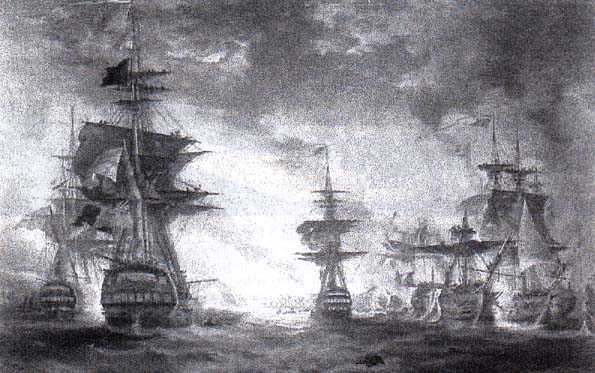 |
FAMOUS SHIPS |
 |
FAMOUS SHIPS |
The L'
ORIENT
I
thought, since HMS BELLEROPHON was covered in last month’s newsletter, it
would be only fair to cover her most famous opponent, the L’ORIENT.
Not that much is known about the ship herself, or at least I could not
find any information as to her structural statistics.
Perhaps if I knew French I could have obtained more information along
this line. What
I did find is fascinating as well as interesting.
She was laid down at Toulon in 1790-91 and was originally given the name Le Dauphin Royal in honor of the little prince later to be known as
Louis XVII. She
was a large 3-decker ship-of-the-line mounting 120 guns, one of the most
powerful units of the French Navy.
In 1795, under her second name, Sans
Culotte, she was involved in the Mediterranean campaign of March against the
British fleet under Admiral Lord Hotham.
She was dismasted on March 14th, but escaped by taking refuge
at Genoa.
The
next we hear of her, she was involved in the fleet that took Napoleon to Egypt.
She was now under her famous name of L’ORIENT.
On July 1, 1798, things looked very rosy for the French and Napoleon.
Napoleon Bonaparte stood on the deck of the L’ORIENT staring at the
coast of Egypt.
He had great plans for Egypt which was reflected in the fact that, along
with the 55,000 soldiers, 1,000 pieces of artillery and other war related items
he brought with him in the approximately 400 ships from France, there were also
engineers, botanists, mathematicians, artists and writers.
Napoleon planned to make Egypt a center of education and enlightenment
once he took the county away from the Ottoman Turkish rulers!
Unfortunately, for Napoleon, Lord Nelson was searching for him and found
his fleet anchored in Aboukir Bay on August 1, 1798. 
The
L’ORIENT was the flagship of the French fleet under the command of Admiral
Francois-Paul Brueys.
The thirteen French vessels were insufficiently manned, in poor repair
after there long voyage, and lacking in trained officers.
They were laying anchored in a single line parallel to and not far from
the Egyptian coast.
Since Nelson’s fleet was sighted in the morning, the French had time to
hold a council of war.
Some urged that they sail out and meet the British fleet at sea, but it
was decided that remaining at anchor in what was considered a strong position
was their best option.
In
the ensuing battle of the Nile the British, under Lord Nelson, surprised the
French by both attacking in the evening (it was 6 o’clock in the evening when
the battle began) and by sailing around the head of the French line and lining
up on both sides of the French battle fleet, instead of just one side, as was
expected. Since
the French fleet was at anchor, they could only look on as the first five ships
in the anchored line were attacked from both sides by nine British ships.
As night fell, the tenth British ship, HMS BELLEROPHON, anchored opposite
the L’ORIENT and engaged her furiously.
The great three decker was more than a match for the British 74, however,
and within a short time the HME BELLEROPHON, badly damaged and with 193 of her
men killed or wounded, had to retire from the firing line.
Another ship took her place, however, since the “front five” were now
out of the fight – the British ships simply moved down to engage the next set
of French warships, including the L’ORIENT.
The French admiral had no intention of stopping the fight, however, and
fought on bravely.
By 10 o’clock in the evening the L’ORIENT was burning fiercely.
The
accompanying photo obtained from the internet shows the L’ORIENT at the moment
of her destruction.
Cleveley, a former ship-caulker and seaman who was later appointed
Draughtsman to his Royal Highness, documents the English navy’s defeat of the
French fleet in Aboukir Bay in the print.
Apparently, leftover paints and solvents from shipboard maintenance were
ignited in the battle, dooming the L’ORIENT and most of its 1,000 crewman,
although many were already mortally wounded, including Admiral Brueys.
The explosion of the ship’s magazine at around 10 P.M. was so stunning
that it caused a temporary stoppage of the battle.
Most of Napoleon’s funding (money) also blew up with the ship, dooming
his grand design’s.
There
is now doubt that the end of L’ORIENT was dramatic and spectacular, eventually
causing Napoleon to sneek away from Egypt and sail back to France, his grand
design exploding with L”ORIENT.